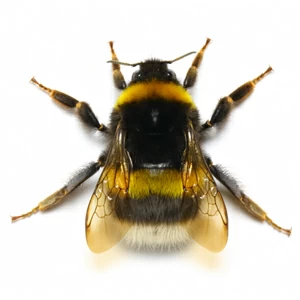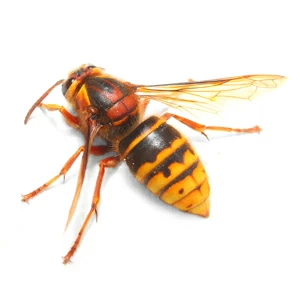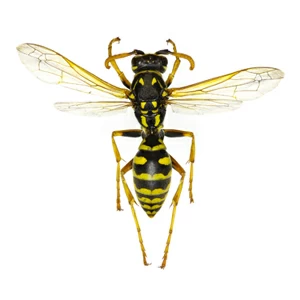Each of these singing insects is distinct, and they each find their own way into your home or outdoor living space. Aerial nests in trees, ground holes, and wall penetrations through exterior cracks and unprotected gaps are also potential nesting places.
Due to the large number of residents in the nest, overuse of goods or incorrect control methods, and the dread of getting stung and the medical risks that may arise, effective control by the homeowner is rare. All of these are good reasons to let ProPest handle wasp nest removal, bee nest removal, and other stinging insect eradication.

Carpenter Bee
Color: Resemble the bumblebee except that bumblebees have dense yellow and black hairs on the abdomen, while carpenter bees have a nearly naked black, shiny abdomen
Legs: 6
Size: Adults are about 2.54cm long
Identifying Characteristics: Shiny, black abdomen; seen hovering around weathered and unpainted woods, although they will nest in a wide range of woods, they prefer softwoods like: pine, redwood and fir
Characteristics of this insect
- Insects that do not establish colonies and live alone. Typically, these pests are annoyances that cause cosmetic rather than structural damage. Many generations of widening existing galleries in the wood can cause significant wood deterioration.
- Carpenter bees, both male and female, spend the winter in old nest galleries and emerge in the spring to mate.
- Rather than digging a new hole, the female prefers to use one that already exists. Female uses strong jaws to excavate a clean-cut, 1.27 cm diameter entrance hole when building a new nest. To construct a tunnel, the hole is perpendicular to the grain for 1.54cm to 5cm, then turns 90 degrees and excavates along the wood grain for 10 to 15cm or more
- The gallery will consist of six to ten eggs that are sectioned off and laid upon a mixture of pollen and regurgitated nectar to feed upon. The female carpenter bee will die soon after.
- The new adults remains in gallery for several weeks, chew through the partition, and venture outside in late August

Bumblebee
Color: Dark reddish brown with deep yellow and brown black markings on the abdomen are similar to the markings found on yellow jackets
Legs: 6
Size: 1.90cm
Identifying Characteristics: Fuzzy appearance; makes loud buzzing sound when flying
Characteristics of this insect
- Social insects that live in nests and colonies. This bee may found nesting in or around structures, beneath landscape features, abandoned rodent burrows, dense clumps of grass, and are a concern due to the numerous bees around flowering plants
- Adults are represented by workers which are sterile females, queens, and males which come from unfertilized eggs in late summer
- A mature bumble bee nest contains 50-400 bees and brood. In late summer, only drones(males) and new queens are reared in nest. Once new queens emerge, they mate and find a suitable place for winter. The drones, old queen, and unfertilized new queens die when winter arrives
- Bumblebees will travel up to 4km for nectar

European Hornet
Color: Brownish with yellow abdominal stripes and a pale face
Legs: 6
Size: Up to 3.50cm
Identifying Characteristics: European hornets have a hairy thorax and abdomen. Females tend to be larger than males. Males have 7-segmented abdomens whereas females have 6. Males have-13 segmented antennae whereas females have 12 segments.
Characteristics of this insect
- Nests are typically located in a cavity such as a hollow tree or wall void , but can occasionally be seen attached to structures. Nests are comprised of chewed-up cellulose from decayed wood consisting of several hundred cells all which is enclosed in a paper envelope
- Workers can sting, but they are not particularly aggressive unless the colony is threatened
- These hornets are unique in their ability to forage at night. It is not unusual for workers to bounce off exterior lights or windowpanes during summer nights

Yellow Jacket Wasp
Color: Typically black and yellow pattern
Legs: 6
Size: Adult are 9.52mm to 1.9 cm long; Queens are about 25% larger
Characteristics of this insect
- Social insect that consist of workers, which are sterile females, queens, who are fertile females, and males, who emerge in late summer from unfertilized eggs
- Only the inseminated queen overwinters and in the spring, uses chewed cellulose material to build up a paper carton or bag nest of few cells. One egg is laid in each cell and the queen initially feeds developing larvae chewed up insects, spiders, and nectar. Nests are constructed in attics, eves, soffits, gaps in exterior construction, false ceilings, and exterior rodent burrows to name a few
- Nest size varies from 500 to 15,000 cells, that contain 4,000 to 5,000 workers at its peak

Mud Dauber Wasp
Color: Black with pale yellow markings
Legs: 6
Size: Adults are 2.5cm long
Characteristics of this insect
- Not social wasps and do not live in colonies
- Mud daubers overwinter as full-grown larvae, pupate in the spring, and emerge shortly thereafter
- Females construct nests of mud. The nest is compromised of a series of cylindrical cells that are plastered over to form a smooth nest
- Females capture several spiders, which are stung and paralyzed and used as a food source for brood. A single egg is deposited on the prey in each cell. The hatching larvae will eat the prey and emerge from the nest
- The nests will exhibit round holes as the wasps emerge. This indicates that the nest is probably old and inactive

Paper Wasp
Color: Yellow with rusty brown or black stripes
Legs: 6
Size: 1.5 to 1.9 cm
Identifying Characteristics: Can range from dark brown in color, with black wings and yellow markings to looking just like yellow jackets in coloration
Characteristics of this insect
- Paper wasp nests are made from plant material combined with saliva to resemble gray paper-like material
- Nests consist of a single layer of paper-like comb with cells pointing downward, which are not enclosed. Nests hang from branches of trees or shrubs, porch ceilings, top of window or door frames, soffits, eaves, and deck railings to name a few
- Nests are not reused the following season
- The wasps attack when aggravated and have a quite painful sting. The insect does not lose its stinger, so it is possible for the wasps to sting several times. The females have a venomous sting that can be threatening to those allergic to wasp venom
feel free to contact our team.
